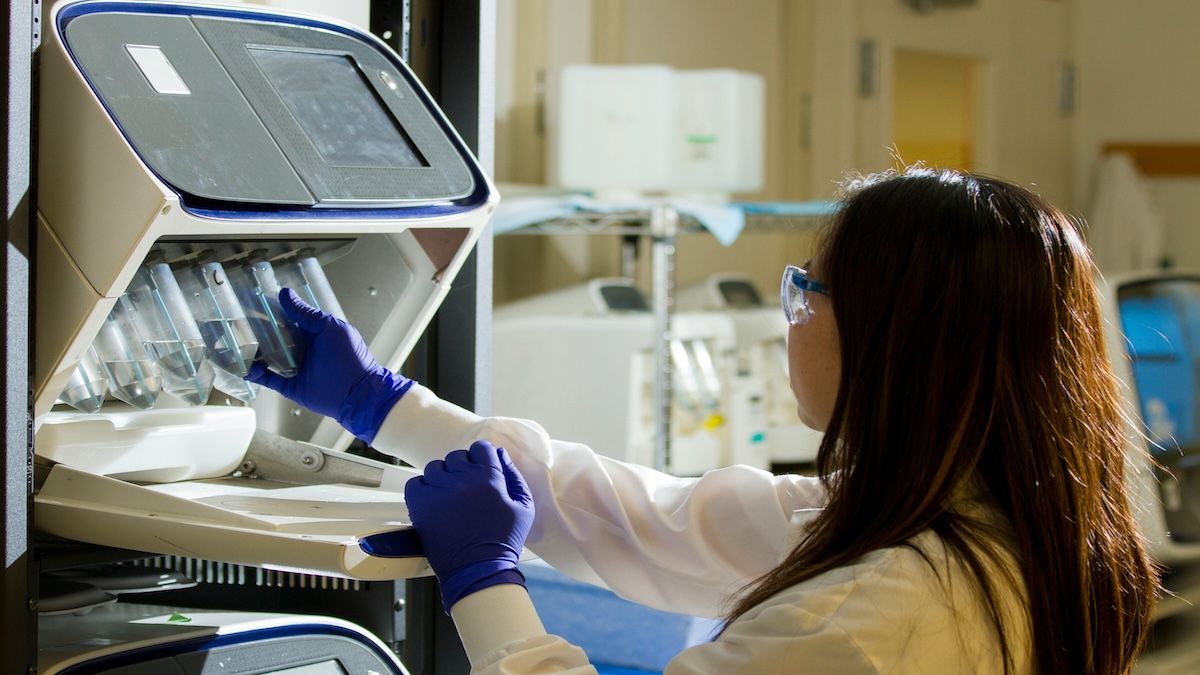The Price of Progress: How Federal Budget Cuts Could Devastate American Innovation
Jake Steckler / Jan 24, 2025
Photo by National Cancer Institute on Unsplash
In 1989, Tim Berners-Lee, a British scientist at the European Organization for Nuclear Research, wanted to make his job easier.
His role required that he organize and share the work of thousands of researchers who inconveniently lived all over Europe and, even more inconveniently, stored their work on incompatible computers. Berners-Lee imagined a decentralized system that could connect these scientists and allow them to seamlessly share their data. With this creative impulse and his knowledge of a bespoke U.S. Department of Defense platform called ARPANET, he birthed the World Wide Web and, with it, our modern idea of the internet.
Berners-Lee famously decided not to patent his invention, adamant about making it a widely accessible, fertile ground for further creativity.
This is how many major innovations originated—from someone motivated to solve a problem, driven not by profit but by discovery, and often funded by the government. Yet, today, many of Silicon Valley’s most influential leaders helped re-insert Donald Trump into the White House, whose administration is hostile to federal agency funding and likely to govern in ways anathema to technological progress. Dismantling the federal agencies that lead and support the nation’s scientific research will have devastating effects on the type of innovation that saves lives and improves our standard of living.
“Government has a really important role in both fundamental and applied R&D,” says Nick Sinai, who served as the Deputy CTO in the Obama White House and is today a venture capitalist. Government funding is needed to spur innovations in the public interest, especially where “market failures” exist, like in the case of clean energy, he notes. With political third rails like social security, Medicaid, and defense spending likely maintaining bipartisan support, Sinai wonders, “What’s left to cut?” beyond R&D.
The MAGA coalition has already revealed itself to be a credible threat to vital government-funded projects. Last month, President Trump and Elon Musk’s recent demands for a leaner budget led Congress to remove funding for child cancer research in the most recent funding bill. Now, a Trump executive order caused the National Institute of Health’s (NIH) operations to abruptly halt, putting frontier biomedical research at risk. An OMB memo further ordered agencies to pause the disbursement of funds for clean energy projects associated with the Inflation Reduction Act.
Many of our truly groundbreaking inventions since the Industrial Revolution are the fruits of research motivated by an intractable problem and fueled by government agencies. Not just the internet, which carries our information across the globe, but the jet engines that power us to physically do the same, and the GPS that steers us the right way. NASA-funded research gave us the baby formula that nourishes our infants, and the NIH and National Science Foundation have enabled many of our most profound medical breakthroughs, from vaccines to MRI machines. Even the duct tape that literally holds things together was borne out of a project greenlighted by FDR during World War II.
Trump’s first administration proposed major cuts to the NIH, NSF, NASA, DOE, and the EPA. His proposals largely failed, thanks to Congress wielding the power of the purse. But with a more politically experienced Trump inner circle and a Republican-controlled Congress—not to mention Elon Musk, who is calling for $2 trillion in federal spending cuts as the head of the Department of Government Efficiency (DOGE)—the odds of Trump having his way are higher this time around. The irony of Musk’s austerity crusade is the early survival of Musk’s Tesla hinged on government grants and subsidies. SpaceX, another Musk venture, has earned over $20B in government contracts since 2008.
Even as Big Tech and a who’s who of major venture capitalists lined up to donate millions to Trump’s campaign and inauguration fund—an unprecedented show of support compared to previous administrations—they owe their very omnipresence to government projects that resulted in not just the internet, but the microchips and touch screens that power its most seductive technology, the smartphone. Marc Andreessen, one of the world's most influential entrepreneurs and venture capitalists, touts the impact of government funding for scientific research, which he cites as one of the keys to “American technology leadership.” Yet he’s one of President Trump’s most outspoken supporters due to his concerns about regulatory overreach by Democrats.
The second Trump administration is taking a more aggressive approach to reshaping federal agencies this time around, with Trump stating his intentions to “dismantle Government Bureaucracy, slash excess regulations, cut wasteful expenditures and restructure Federal Agencies.” Trump’s presumptive Director of the Office of Management and Budget (OMB), Russell Vought, has lobbied for expanding the budgetary power of the executive branch to supersede that of Congress and called for replacing career civil servants with political appointees.
In Trump’s first days in office, he’s implemented a sweeping hiring freeze, halted funding for clean energy grants and loans, and directed all health agencies to pause all external communications, including scientific reports. Trump has threatened to eliminate the Department of Education (DOE) altogether, drawing additional concerns about how the funding cuts may impact the innovation of future generations. “Entrepreneurship can be taught,” Bill Aulet, Managing Director of the Martin Trust Center for MIT Entrepreneurship, evangelizes. But that requires educational support for those who are under-resourced, and much of that funding comes from the DOE. “Lack of social mobility, lack of meritocracy, that’s what worries me,” says Aulet.
78% of U.S. adults say that government investment in scientific research is worthwhile for society. Historically, federal funding for research and development exceeded that of business until 1980, when that trend reversed. By 2020, roughly three-quarters of all R&D funding came from industry, and the gap only looks to widen during Trump’s second term. Within private sector R&D budgets, 80 cents of every dollar goes toward market-driven development, whereas most government research goes toward basic scientific exploration and discovery. This makes business sense; there’s an inherent financial risk to taking uncertain swings on costly, long-term projects. But what often leads to groundbreaking, transformative discoveries is the type of basic, exploratory research in which government and academia specialize.
Nur Ahmed, a postdoctoral Digital Fellow at MIT whose research focuses on innovation and artificial intelligence, explains the inherent tradeoffs between government and industry-driven research. Federal funds support those “trying to solve a problem,” often with “immense impact on our wellbeing.” He acknowledges the private sector’s role in distributing access to new technologies. “We need industry actors to commercialize [innovative technologies].” But incentive misalignment can be troubling. “The direction of innovation is a big concern,” he says. “If profit is driving your technology, it might not be optimal socially.” In healthcare, this produces a “valley of death” where life-saving discoveries fail to scale because the industry has deemed them too financially risky—which leads the pharmaceutical industry to capitalize on technologies with clear commercial viability, like Viagra, but neglect those less likely to produce profits, like Ebola vaccines.
Ahmed also worries that “the scientific labor market will be negatively affected…by the sheer presence of Trump.” He points out that Trump’s first term led to a statistically significant reduction in immigrant and non-immigrant visas, like H1B work visas, the subject of great debate between rapidly separating MAGA factions, as tech leaders who rely on these visas to attract top talent feud with anti-immigration hardliners. These visas are not just critical for building a talent pipeline for Big Tech but for scientific research. Of all doctoral students and postdocs in the US—those who generally drive groundbreaking research—roughly half are immigrants. Colleges have recently warned returning students about potential travel bans, urging them to return to campus prior to Trump’s inauguration.
The funding gap between public and private R&D has also been accompanied by a major shift in who can afford to conduct frontier research and, accordingly, where top talent ends up. A 2023 paper by Ahmed and other MIT researchers revealed two alarming trends in AI research. First, the tech industry’s share of the largest AI models grew from 11% in 2010 to 96% in 2021. Second, the share of AI PhDs working for tech companies has more than tripled in the last twenty years.
Jim Waldo, a Professor of Public Policy at Harvard Kennedy School and the CTO of Harvard’s School of Engineering and Applied Sciences, has seen this firsthand. “I’ve had colleagues who say, Look, we have to get the resources to train our LLMs,” he says, referring to compute-intensive large language AI models like ChatGPT. “I tell them they need to quit their job and get a job at Google or Amazon or OpenAI,” he wryly recounts.
Much of the Trump administration’s impact on innovation will rely on majority support in the House and Senate, which control the federal budget and maintain authority on immigration policy, including the laws that dictate how employment and educational visas are awarded. If Congress falls in line with the President, basic R&D may rely on philanthropic funding. While donations for scientific research have grown in recent years, they often originate from the same tech entrepreneurs driven toward market-based solutions, raising concerns among scientists.
Harvard’s Waldo remains steadfast in his belief that critical research will continue to happen regardless of funding source. What innovators have in common “is that they are small groups of people who are rabid over an idea and convince others that their idea might work,” he explains. “Even in the private sector, it happens that way.”
Expressing far less optimism, 82 American Nobel Prize winners signed an open letter in the lead-up to the election, outlining their concerns with a Trump presidency. “America’s leadership in [science and technology] requires budgetary support from the federal government,” the letter stated. His victory would “jeopardize any advancements in our standard of living, slow the progress of science and technology, and impede our responses to climate change,” they warned.
Sinai, the former White House official, thinks the Trump administration “will be more effective than it was last time” at achieving its political aims. But he maintains some confidence in Congress’s power of the purse to prevent budget cuts at “absurd levels,” like those proposed by Musk.
A policy approach that encourages innovation is one that prioritizes funding for basic research, actively attracts the world’s best talent to the United States, and places a premium on education. Preventing catastrophic impacts to the agencies that have long enabled the critical R&D on which America relies will only require a few Republican congress members to vote against the Trump coalition’s proposals. But critics fear that Congressional loyalty to Trump is stronger than ever before. Texas Representative Troy Nehls recently stated on MSNBC, “If Donald Trump says ‘jump three feet high and scratch your head.’ We all jump three feet high and scratch our heads.” If Congress toes the line on anti-R&D policies, American innovation will falter at a time when it’s desperately needed.
Authors
